International Journal for Parasitology: Parasites and Wildlife ( IF 2.0 ) Pub Date : 2020-01-18 , DOI: 10.1016/j.ijppaw.2020.01.007 Rodney A. Bray

|
The developments in the study of digeneans of deep-sea fish in the 21st Century are documented and discussed. Most recent work has been on the bathyal fauna (i.e. 1,000m-2,999 m depth), with virtually nothing on the abyssal fauna (i.e. deeper than 3,000 m). The one study on hydrothermal vent digeneans has indicated that these regions probably harbour a distinctive fauna. The demarcation of the deep-sea fauna is blurred at the poles, where the cold-adapted fauna appears similar to the shallower bathyal fauna. The abyssal fauna, however, appears distinct, possibly due to adaptations to variable or ultra-high pressures. The digenean fauna of bathypelagic fishes is depauperate. Recent phylogenetic studies reinforce the view that the typical deep-sea fauna has radiated in the deep-sea. Encroachment into the deep from shallow water is relatively rare. Overall, the digenean fauna in the deep-sea is distinctly less diverse that the equivalent fauna in shallow waters. A major conclusion is that our understanding of the deep-sea digenean fauna is poor, and that much further work over a much wider area is needed.
中文翻译:

深海硬骨鱼类的第二代寄生虫:进展报告
记录和讨论了21世纪深海鱼类的双基因的研究进展。最近的工作是在水生动物区系(即1,000m-2,999 m的深度)上进行的,而在深海动物区系(即3,000m以下)上几乎没有任何研究。一项关于热液喷口双基因的研究表明,这些地区可能拥有独特的动物区系。在两极,深海动物区系的划分是模糊的,冷适应的动物区系看起来与浅水区的动物区系相似。然而,深海动物区系似乎与众不同,可能是由于适应了可变或超高压。浮游鱼类的双属动物是绝de的。最近的系统发育研究强化了这样一种观点,即典型的深海动物群已经在深海中辐射。从浅水区侵入深水区的情况相对罕见。总体而言,深海中的双系动物区系的多样性明显不如浅水区中的同类动物。一个主要结论是,我们对深海第二代动物区系的了解很差,需要在更广阔的地区做更多的工作。











































 京公网安备 11010802027423号
京公网安备 11010802027423号